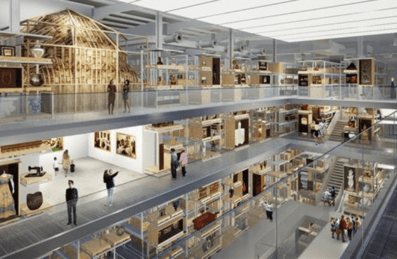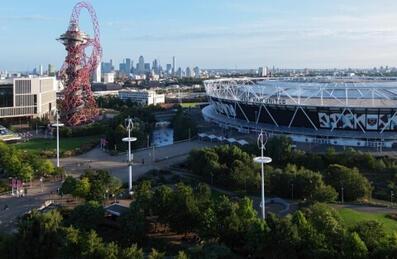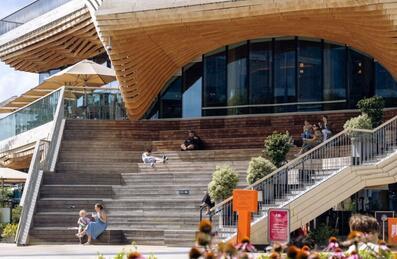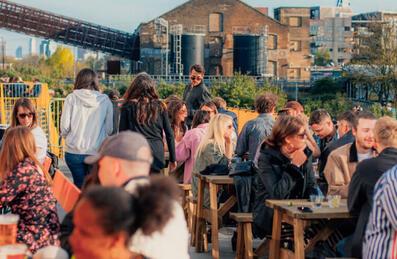
Popular Searches:
Keep up to date
Sign up today for exclusive offers and incredible experiences you won’t want to miss at Queen Elizabeth Olympic Park.
Sign up nowQueen Elizabeth Olympic Park Strategy to 2025
Queen Elizabeth Olympic Park Strategy to 2025
Story 08/07/2021
LLDC has recently published its Queen Elizabeth Olympic Park Strategy to 2025. The strategy outlines how we will position Queen Elizabeth Olympic Park at the heart of London’s recovery as the capital starts to look beyond the Covid-19 pandemic, supporting local communities and businesses, driving innovation and investment, and maintaining its status as a world class destination.
Why do we need a new strategy?
The Queen Elizabeth Olympic Park Strategy sets out LLDC’s commitment to work with our partners to deliver a bold vision for the Park, which will see it continue to develop as an innovative and globally focused metropolitan centre while retaining a strong focus on community and opportunity for local residents. We know that there are challenges as we recover from the Covid-19 crisis, but there are also huge opportunities for us to build on the success of the Olympic legacy, to address deep-seated inequalities, and to make a positive difference to the area and the people of east London.
What are the key priorities over the coming years?
Together with our neighbouring Boroughs we want to ensure that the benefits of investment in east London are felt as widely as possible. We will be overseeing a great deal of change over the next few years with the opening of East Bank and the completion of residential developments, and we are committed to ensuring that this brings real and tangible opportunities for local people as well as raising the profile of the area more broadly. We will also be working with the London Borough of Newham to develop plans for the long-term redevelopment of Stratford Station, and enhancing local connections to the Park to make it as accessible as possible for everyone.
How has Covid affected the strategy? Will the pandemic have impacted large scale projects like East Bank?
Addressing the economic, health and social challenges arising from the Covid-19 pandemic will be a major priority for many years to come. Together with the neighbouring Boroughs we are committed to supporting the Mayor’s vision for London recovery, addressing deep-seated inequalities and creating a positive future for everyone.
It is clear that during the pandemic local people really valued the Park as a safe environment in which they could engage with nature, and meet up with friends and family, to benefit their mental and physical wellbeing. The value of community networks in and around the Park was also evident, with local organisations stepping up to support those most affected by the pandemic, for example organising outreach services and food distribution hubs. This sense of community is something we want to continue to build on going forward.
The pandemic has inevitably affected our developments on the Park, with sites having to temporarily close and then operate with social distancing rules in place. Despite this, construction is well underway for East Bank, as well as for our various residential neighbourhoods. The BBC, London College of Fashion, Sadler’s Wells, the V&A and UCL are preparing to open their doors from 2022 onwards, which will make a huge impact on the area.
What are you looking to do for young people in east London?
We work closely with young people in a range of ways, and this will continue to be a strong focus. The GO! Schools Network encourages schools in east London to make use of the Park through a range of outdoor learning resources linked to the National Curriculum, and our East Education framework is designed to maximise the learning opportunities that can be realised locally in relation to East Bank. The hugely popular annual East Summer School offers a range of courses and activities for local young people to help them to develop new skills and passions. This year we ran our first East Careers Week with East Bank partners offering insights into a range of creative, digital and STEAM careers including construction, fashion, broadcasting and engineering.
Young people from the four neighbouring Boroughs fed into the development of the Queen Elizabeth Olympic Park Strategy, and will continue to input into our plans, design and development proposals, through the Legacy Youth Voice and Board. In addition, we have recently established an annual Youth Conference to enable young people to engage with policy makers on key issues. It is crucial that young people feel that the Park is a place for them, a place in which their voice can be heard, and a place which offers genuine opportunity for their future.
You speak about Transition in this strategy. What is Transition and what are your initial plan?
The Mayor of London has committed to keep the existence of all Mayoral Development Corporations, such as LLDC, under review. While there is still significant work to do to fulfil the legacy commitments made in the original London 2012 bid, it is anticipated that key objectives will have been delivered by 2025. Transition refers to the process of agreeing what will need to be in place beyond 2025 to oversee the long-term management of the QEOP estate, to realise the ongoing delivery of legacy, social and economic aims, and to coordinate future inward investment and strategic oversight of the area.
It has already been agreed by the Mayor of London that LLDC’s Town Planning powers will return to the relevant Boroughs by 31 December 2024. It is also recognised that some form of successor arrangements for LLDC will be required. Agreeing what such arrangements should look like in terms of remit, structure and governance will be a major focus for LLDC, working closely with its partners and in particular the neighbouring Boroughs, over the coming period.
The Queen Elizabeth Olympic Park Strategy is available here.






